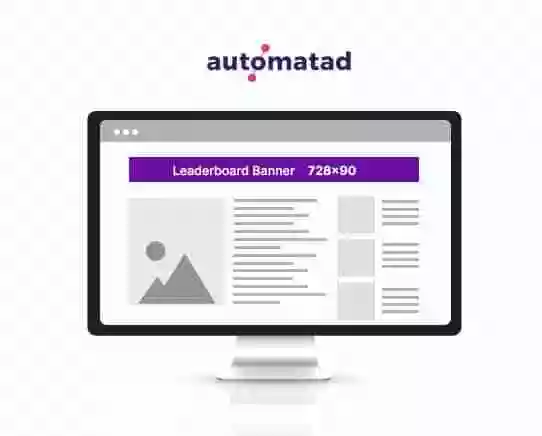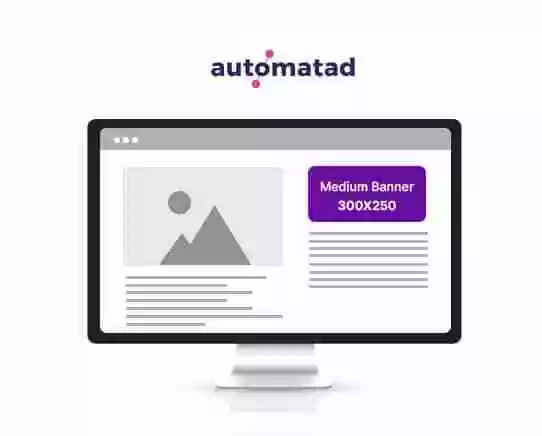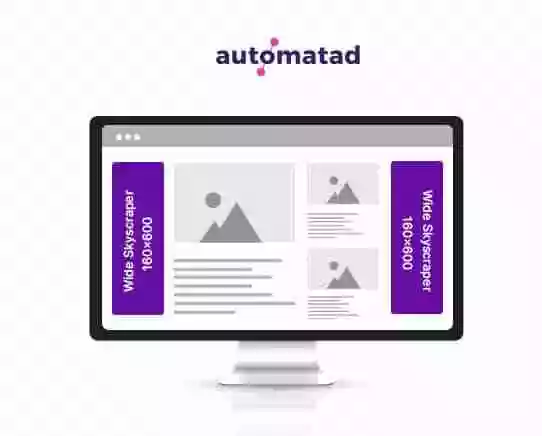A rising tide lifts all boats, and the same goes for digital advertising. According to Magna, despite the economic turbulence, digital advertising sales will grow by 8%, reaching $557 billion in 2023, and will account for 65% of the total ad sales. This surge in the online economy shows a growing preference among businesses to use digital advertising to reach their desired audience. Billions of dollars are being poured to reach the desired consumers online.
Banner ads play a critical role in this process, providing a cost-effective and efficient way for advertisers to reach the relevant audience. For the U.S. market alone, banner ad spending is expected to reach 81.3 billion dollars by 2026. Thus, as a publisher, you need to pay extra attention to optimizing your banner ads to increase the value of your digital real estate.
That being said, the various sizes and formats of banner ads are an essential part of this optimization strategy as they substantially impact the success of an advertising campaign. By recognizing the value of banner ads and utilizing them strategically, you can influence their click rates and thus increase your revenue. In this article, we will discuss the top-performing banner ad sizes, their popularity, and the best practices for using these sizes to increase ad earnings.
Table of Contents
What Are Banner Ads?
Banner ads are ads in banner shape (usually rectangular) ingrained at the top, bottom, or along the side of the host website. They are placed either horizontally or vertically to display graphical ads with embedded links. Once clicked, the link takes the users to the advertiser’s website. The ad creative used in the ad spaces can be an image, text, or a combination of both, with image-based ads being the most popular.
Banner ads can be static or dynamic and are placed in high-traffic areas to increase their visibility and the likelihood of being clicked. These ad spaces can be bought and sold through ad networks or direct negotiations between advertisers and publishers. The banner ads come in various sizes and shapes, such as square, leaderboard, skyscraper, or mobile leaderboard, to fit different devices, website designs, and layouts.
Why Are Banner Ads Successful?
Banner ads are a successful form of advertising due to their longevity, versatility, and ability to deliver results for both publishers and advertisers. They have been a staple in online advertising for over two decades, and for a good reason.
Banner ads are a popular and successful way of monetizing your content and website traffic. They offer an extensive reach, cost-effectiveness, non-intrusive design, ease of implementation, and the ability to track and optimize performance. Additionally, users are generally familiar with banner ads.
For advertisers, banner ads are the most cost-efficient tool for increasing brand awareness, driving conversions and retargeting potential customers.
Related Read: 7 Ways (Pro Tips) Publisher can Increase Banner Ads CTR
Why Banner Ads Sizes Matter?
Ad sizes play a crucial role in the success of banner ads and increasing revenue. Different sizes of banner ads allow for flexibility in ad placement and website customization.
It can also significantly impact performance and engagement. Users may overlook a banner ad that is too small, while an ad that is too large may be intrusive and drive users away from the website. Also, while ad networks offer various ad sizes, specific sizes, such as leaderboard or skyscraper ads, are the most preferred by advertisers and generate higher revenue for you.
Top Performing Web Banner Ad Sizes for 2023
With many ad sizes available, it can be overwhelming for publishers to decide which sizes to offer on their websites. However, as advertisers typically prefer only a few web banner ad sizes, it makes it easier for you to narrow down the options. However, before deciding, you must consider the impact of the selected ad size on your content and the resulting user experience.
- Leaderboard (728×90) – This size is the most common and is typically placed at the top of a web page. Advertisers prefer it as it offers a larger space to display their message and can be a highly effective format for promoting brand awareness. It also offers higher viewability, and because of all this, you can sell them at their maximum value.

- Large Rectangle (336×280) – This size is commonly used for display ads and provides ample space for advertisers to showcase their product or service. It’s a good option for publishers looking to offer a balanced ad experience for their users and is often used in the middle or at the bottom of a webpage.

- Medium Rectangle (300×250) – Also called an ‘inline rectangle’, this size is often used in content-rich websites and provides a compact space for advertisers to display their message. It’s a popular choice for publishers looking to monetize their sites without sacrificing user experience.

- Skyscraper (120×600) – This size is perfect for vertical ads and is typically placed on the side of a web page. Its tall, narrow format makes it easy to fit into smaller spaces and still be visible to visitors. It’s a good option for publishers looking to offer a unique ad experience for their users.

- Wide Skyscraper (160×600): This size is similar to the Skyscraper but with a wider format. Typically placed on the side of a web page, it provides a clean and simple format for advertisers to display their message. It’s ideal for displaying larger images and more detailed text while being compact enough to fit in smaller spaces.

- Large Skyscraper (300×600): Also known as a ‘half-page ad’, this size offers a unique and impactful way to display ads, providing a larger space for advertisers to showcase their message while maintaining a vertical format. It is well-suited for websites with much vertical space, allowing publishers to monetize their sites without sacrificing the user experience.

Top Performing Mobile Banner Sizes for 2023
As compared to desktops, mobile has fewer choices when it comes to banner ad sizes. However, there are still several prevalent sizes that are widely utilized. These sizes have been carefully calibrated to accommodate mobile devices’ smaller screen sizes and aspect ratios while balancing user experience and ad visibility. The most popular static banner sizes for mobile are:
- Mobile Leaderboard (320×50): One of the most popular mobile banner ad sizes, this format is compact and unobtrusive, designed to sit neatly at the top or bottom of a mobile screen. This format is popular for its minimal height, so it enables you to serve ads and display your precious content without hampering the user’s navigation or browsing experience.
- Medium Rectangle (300×250): This size is particularly versatile due to its more balanced height and width, offering a larger canvas for advertisers to deliver more detailed messages or visuals.
- Mobile Banner (300×50): This format is compact, just like a mobile leaderboard, and can seamlessly integrate with your user’s browsing experience. It’s suitable for publishers and is loved by advertisers who prefer a less intrusive presence while still reaching their audience effectively.
Large Mobile Banner (320×100), Mobile Full Page Flex (320×320), Square (250×250), and Small Square (200×200) are other mobile banner ad sizes.
Related Read: Best Mobile Ad Formats and Ad Sizes to Increase Viewability and Revenue.
Best Practices for Banner Advertising
- Designing and Creating – When designing and creating banner ad spaces, it’s important to consider the size restrictions. You should also ensure that the creatives being served in the spaces are visually appealing and have clear messaging so that you don’t miss out on chances of conversions.
- Implementing These Sizes in Ad Campaigns – You should work with advertisers to determine which sizes will work best for their campaigns and ensure that the ads are placed strategically on your website. This will help to maximize revenue and provide a positive user experience for your visitors.
- Testing and Optimizing Ad Performance – You should regularly test and optimize your ad performance to ensure that they are maximizing revenue and providing a positive user experience for your visitors. This can be achieved through A/B testing, conversion tracking, or user feedback. Each content has its own unique demand, and your ad sizes and format must be designed accordingly. For the best result, you must keep on experimenting with different sizes.
- Treating Banner Blindness – Banner blindness is a web-user behavior where they consciously or unconsciously ignore the banner-like information present on the web page. With so many ads being displayed on websites, users have become immune to them and tend to ignore them. You need to be proactive in your approach to overcome the challenges of banner blindness. In this case, you can increase ad viewability and revenue generation potential by experimenting with different ad placements and serving appealing, relevant ads.
How to Implement Banner Ads?
Banner advertising is one of the most effective ways of monetizing your content. To implement banner ads on your website, you can:
- Sign up with a display network: You can connect with a trusted and reputable display network, like Google AdSense, to start selling ad spaces on your website.
- Install a script: The display network will provide you with a script to add to your website. This script will enable the display of banner ads.
- Automated delivery: Once the script is installed, the display network will deliver targeted ads to your audience.
- Get paid: You will be paid based on the selected ad payment model.
You can also choose a trusted monetization partner to implement banner ads on your website. The monetization partner will not only take care of implementing a profitable ad size and format but will also connect you with suitable demand. This way, you can focus on creating quality content for your audience while your monetization partner takes care of the rest.
FAQs
Q1. What are the most common banner ad sizes?
The most common banner ad sizes are Full banner (468×60 pixels), Leaderboard (728×90 pixels), Half-page (300×600 pixels), Medium rectangle (300×250 pixels), Large rectangle (336×280 pixels), Skyscraper (120×600 pixels), Wide skyscraper (160×600 pixels), Large leaderboard (970×90 pixels), Square (250×250 pixels), and Small square (200×200 pixels).
Q2. How do I choose the right website banner ad size for my audience?
Choosing the right website banner ad size depends on several factors, including the layout of your website, the type of content you publish, and the target audience you are trying to reach. You should also consider the preferences and habits of your target audience and choose the ad size that will offer the best balance of visibility and impact.
Q3. How can I ensure that my website banner ads are seen and effective?
Publishers can ensure that their website banner ads are seen and effective by choosing the right ad size and placing the ad in a prominent location on the website.























